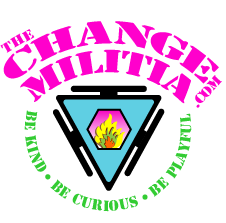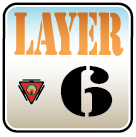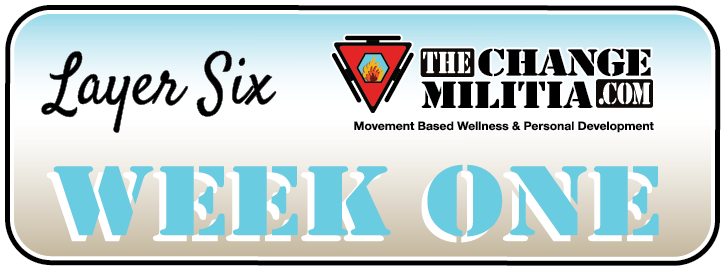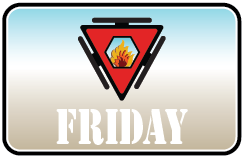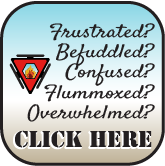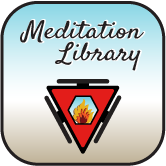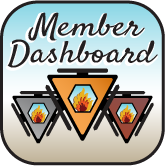
Layer Six, Week One – Sunday
- Morning – Watch Videos and Read Instructions Hara Breathing and Center – Off Center
- Evening – Read Week One Concepts
- Evening – Practice Hara Breathing and Center – Off Center
As a carry-over from last week, spend some time examining the people you know best and see if you can identify their blind spot. You are looking for the thing they do or neglect that has the biggest non-beneficial impact on their lives (no matter what, keep your observations to yourself … you might not be right and it is highly unlikely your opinion will be welcomed).
Last week we discussed how your greatest strength creates imbalance and the destabilizing effects of your blind spot. This week, we will start out looking at what you perceive as your biggest weakness.
Your third largest area of imbalance is probably what you see as your biggest weakness but probably not for the reason you think.
What you see as your biggest weakness is probably just the thing that works the best to bleed off your excess energy. It is a very effective distraction.
You use your biggest weakness as a scapegoat. You spend a bunch of energy thinking about it, talking, emoting, comparing, judging, hating, remembering past incidents, and projecting future incidents of it. How often do you feel yourself getting too expanded, yank on your chain and pull yourself back into a comfortable place by thinking about or dealing with your biggest weakness?
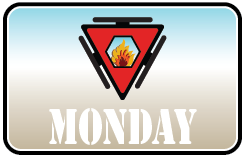
Layer Six, Week One – Monday
- Morning – Practice Hara Breathing
- Evening – Monday Concepts
- Evening – Practice Center – Off Center
Your turn. Spend the day with a deep curiosity for your blind spot. Remember, it is called a blind spot because it is usually very hard to see. Be open to something obvious that you disregard and to something you repress.
As a hint, you won’t currently be giving it very much attention or value. It is hidden and will not be readily apparent.
Reflect on the aspects of a partner, family member, or co-worker and list the things that most frustrate, annoy, vex, irritate, embarrass, perplex, or make you the most uncomfortable (what you perceive as their biggest weakness/imbalance/dysfunction).
Spend some time on this. It is very powerful and can change, fundamentally, the nature of every relationship you have. When you can identify why you label, judge, and condemn you will realize every external judgment reflects an internal fear or a way to diffuse energy.
After you have identified something, put it in context to their entire being. How important is it really? Does it justify the amount of energy you give it? Is it just a convenient way to create and maintain distance, limit intimacy and connection, or bleed off your excess energy? Are you using it as a surrogate for your own self-judgment or are you using it to take your focus away from a bigger problem?
Every judgment is a subconscious need for distraction.

Layer Six, Week One – Tuesday
- Morning – Practice Hara Breathing
- Evening – Read Tuesday Concepts
- Evening – Practice Center – Off Center
Spend the day cataloging your distractions. When you catch yourself in distraction, label the distraction as either greatest strength, greatest weakness, or blind spot. Review Layer Five, Weeks Three and Four, if necessary.
What you see as your biggest weakness is probably just the thing that works most effectively to bleed off your excess energy. Go through the previous example with what you think is your biggest weakness. Reflect on the aspects of your personality that most frustrate, annoy, vex, irritate, embarrass, perplex, or make you the most uncomfortable.
What do you spend the most time and energy pondering, ruminating, or obsessing about? How important is it really? Does it justify the amount of energy you give it? Is it just a convenient way to create and maintain your distance from others, limit your intimacy and reduce the amount of connection you have? Do you use it to bleed off your excess energy?
Here is an example:
I have recurring pain from a botched surgery in my early 30’s. It has been 20 years and rarely do more than a couple of days go by without some degree of discomfort. Sometimes it is a nagging twinge, sometimes a dull ache and sometimes it is more severe, making me nauseous.
When I am focused, immersed, and passionate about what I am doing, the pain is background static, easily ignored, regardless of its intensity. I have come to understand that I create labels and stories about the pain when I am looking for excuses to be distracted.
Depending on what else is going on in my environment, my recurring pain is either very important, of equal importance, discounted, or forgotten. I subjectify the pain.
The pain is important to the degree my subconscious mind is looking for a distraction.
When I don’t want to be distracted, I devalue the pain, regardless of its intensity. It is still there, I choose not to give it any attention. I allow it to exist. When my subconscious mind is looking for something to lower my vitality, it starts waving the pain in front of my face.
The objective amount of sensation in the pain is the same regardless of how I value it. I am deciding in every moment how much attention I want to give my current set of sensations.
And that is just as true for everything else in my life. Pain, pleasure, history, trauma, relationship, future, they all have only the value I choose to give them. I have the ability to label and classify my environment according to my intentions and the direction I want to go. I can allow things to diffuse and distract me or I can let them be, without giving them attention.
I have recurring pain, I can create a ball and chain with it … or I can choose to give my attention to something else, something interesting, fulfilling, and fun.

Layer Six, Week One – Wednesday
- Morning – Practice Hara Breathing
- Evening – Read Wednesday Concepts
- Evening – Practice Center – Off Center
When you have dissected your greatest weakness, spend some time feeling what your life would be like if you didn’t fixate or value that weakness. How much more time and energy would you have for other, fun, fulfilling, and productive things?
Have you ever wondered why you don’t just deal with your biggest weakness?
Your biggest weakness is manageable. The reason you chose it wasn’t because it was the most grievous but because you could worry about it without fear of overwhelm. You can deal with it and still get on with the rest of your life. You have adapted to it. It is familiar, tolerable, and survivable.
However grievous or heinous you feel your weakness to be, ask yourself how much it has changed in the recent past. You deal with it daily, like brushing your teeth or tying your shoes. It persists because it (however unpleasant, unproductive, or unkind) is tolerable. Your subconscious mind finds it a handy way to lead you to distraction.
In the above example, my pain is something I deal with. Another surgery may or may not fix it. It could make it worse. I have chosen to not take the chance. My pain exists. The choice I have is what to do with the pain. I can choose to let it become my focus or I can accept its inevitability and move on. When I allow it to exist without giving it any value (using it as a distraction), it doesn’t influence my actions and movements. When I give the pain value, it lowers my motivation, depresses my mood, and changes the way I move.
My choice is to change the label I put on it. I can make it less important by giving it much less mental and emotional energy. If your biggest weakness is something that can’t easily be changed or altered, change the way you interact with it. Allow it to exist as background noise.
If your biggest weakness is changeable, begin making subtle changes to the pattern.

Layer Six, Week One – Thursday
- Morning – Practice Hara Breathing
- Evening – Thursday Concepts
- Evening – Practice Center – Off Center
Reassess what you have considered your greatest weakness and put it in context. Is it really that big of a deal? Does it justify the tons of energy you give it? How hard would it really be to change? How easy would it be to change something about it? Why haven’t you? What if you did? What if you did something to moderate the weakness today?
So, if your biggest weakness isn’t your biggest weakness (just your best distraction), what are your areas of imbalance, resistance, stagnation, and neglect (things you willfully or subconsciously ignore)?
The first step in achieving balance is determining what your baseline is (see last week’s Daily Focus). Find what is working for you and be honest in your assessment of what needs improvement.
In Friday’s focus, you will have the opportunity to chart your relative balance. Here is what mine looks like at the time I wrote this. As you can see, my components that are the farthest from optimal are Endurance, Speed, and Focus. My body that is most out of balance is Physical.
My strong point is Flexibility. My strongest body is emotional, although each of them (other than physical) is pretty close.
When I look at these, I can see that I need to get back in physical shape by working on my endurance, speed, and focus. What is interesting is that for most of my life, those things would have scored the highest. It has been a long, cold winter here in Central Oregon and I didn’t prioritize staying in shape and imbalance ensued.
This didn’t really tell me anything I didn’t know. I know I am out of shape but seeing it, seeing it in comparison to my other bodies and components helped to cement my resolve to change my behaviors and prioritize fitness.
Layer Six, Week One – Friday
- Morning – Practice Hara Breathing
- Evening – Friday Concepts
- Evening – Practice Centered, Off Center
Here is way to suss out your current imbalances. Make a list of the seven components and beside each one list each of the 5 bodies. Go through and give each of the thirty-five options a number from 1-10 with one being the most unbalanced. Follow this model.
So why aren’t you and I balanced more often? Why doesn’t your system default to balanced and fluid? What are the mechanisms that pull you off-center? Your sub-conscious mind is the primary culprit. Both fluid and balanced lead to growth, growth requires change, and your subconscious mind does not like change. So, it sabotages your balance and hinders your fluidity to keep you in a familiar place.
Simply put, your subconscious mind is concerned with two things: threat assessment and homeostasis.
Homeostasis has a lot of beneficial attributes. It keeps your blood oxygenated to a healthy level, controls your heartbeat, respiration, and blood sugar, and replenishes energy to the cells. It helps maintain body temperature, blood pressure, and cellular hydration. Homeostasis keeps your bodily functions and chemistry in a survivable range. It is not concerned with growth or optimal effectiveness; it is seeking average, comfortable, and safe.
Physical Homeostasis sometimes gets it wrong; you sweat when you are not hot, your blood sugar falls out of healthy ranges, your heart races, and you get light headed from lack of oxygen. You get headaches, indigestion, rashes, you might crave sugar, alcohol, drugs, sex, gambling, shoes, etc.
Your subconscious mind co-opts homeostasis to keep you thinking and emoting in a familiar and narrow range. Do your palms ever get sweaty? Sweaty palms don’t have any physical benefits. Sweaty palms are an emotional response that has high-jacked your sympathetic nervous system. When your palms are sweaty, are you actually in danger? First dates, job interviews, and meeting the future in-laws are rarely life threatening but your subconscious mind is so afraid of the unknown that is tries to convince you they are … and then your palms sweat as you limit the possibilities and ignore the opportunities that may take you out of the familiar.
The justification your subconscious mind uses is fear of pain, injury, or death. It is trying to keep you safe. Your subconscious mind is very black and white; safe or unsafe, good or bad, life or death.
The opportunity you have is to override your subconscious mind and make decisions that have long-term benefits.
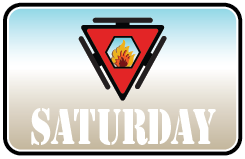
Layer Six, Week One – Saturday
- Morning – Practice Hara Breathing
- Evening – Saturday Concepts
- Evening – Practice Center – Off Center
Spend the day reviewing your list. Verify that you were being as forthright as possible and adjust it as necessary. Highlight the lowest numbers and reflect on your options to improve.
So, to achieve fluid balance, you will parent your subconscious mind with your conscious mind. You will direct and train, override and decide, and determine the path that leads to long-term growth, health, happiness, fulfillment, and success.
The first step is to bring your low levels of collaboration up to match your higher levels. After you get your levels aligned (you are balanced), begin to raise all your levels simultaneously. Override your subconscious mind when necessary and learn to discern the feeling of being unbalanced sooner.
When you do, everything from tying your shoes to tying the knot will get easier. You job, family, relationships, and hobbies will become opportunities to flourish, frolic, and fascinate. You will smile more … and more people will smile back. It will feel as if a very large and unpleasant weight has been removed from your spleen.
Next week some specific tools to achieve balance and stay balanced.
Hara Breathing
Step 1 – Find a comfortable seat.
Step 2 – Take a physical, mental, environmental, and emotional inventory.
Step 3 – Allow yourself to settle, your mind to quiet, and breath normally.
Step 4 – Begin to focus your mind on your Hara Point (2” below your navel and just in front of your spine).
Step 5 – Focus your senses on your low belly. Continue to breathe easily.
Step 6 – Confirm your intention to absorb more energy than you think is possible into your low belly.
Step 7 – If your mind wanders, re-engage with your intention. Be determined.
Step 8 – Your focus is coalescing from each of your bodies.
Step 9 – Every couple of minutes, stop and assess what you are feeling in your Hara Point (low belly).
Step 10 – Feel for changes in your physical body.
Step 10 – Each time you stop, assess your environment. How does the world feel different to you?
Step 11 – What might you be feeling that you have never felt before?
Step 12 – Continue. Focus on your Hara Point with the intention to absorb more energy than you think is possible and then stop and assess the nature and quality of your being and the nature and quality of your environment.
Why it Matters – This powerful Kriya is the floodgate to the flow state. Being in the flow state (Samadhi, Nirvana, Ecstasy) is the ability to instantaneously feel and metabolize the energy in and around you. This absorb and discern movement is the next step.
Everyday Usability – If you were only going to do one meditation for the rest of your life, this might be the one. This simple mediation embodies presence, vitality, and awareness. Use this whenever you want to get deeper, fuller, and more connected to yourself and the world around you.
Progression – This practice creates its own progression. When you do it consistently, things change. Perceptions, your views and relationships to the world will shift. An analogy would be to grow up with only radio and then be introduced to black-and-white TV, then color TV, and then IMAX 3D in a movie theater. When you knew only radio, it felt amazing and magical and IMAX 3D would have been inconceivable. Wherever you are in your progress, know that there is something beyond it. It won’t be long before TV and computer screens cease to exist as they are replaced by holographic projection devices… which will be replaced by content transmitted directly into the brain.
Step 1 – Take a Current30, take a few deep breaths, and allow yourself to settle.
Step 2 – Stand in front of a something about waist height that you can lean on.
Step 3 – Step back and rest your hands on your waist height object. Try to have about 30% of your weight on your hands and your body on at least a 30-degree angle from vertical.
Step 4 – Relax your feet so that your heels are down or your calves are stretched.
Step 5 – Tuck and untuck your tailbone to determine the range of motion of your core and hips (pelvic tilt).
Step 6 – Find the middle or neutral place in your range of hip/core movement.
Step 7 – Consciously maintain the neutral place throughout this exercise.
Step 8 – Once you are leaning forward with a neutral pelvic tilt, bring your awareness to your Hara Point.
Step 9 – Feel for your Hara Point as you allow that regardless of your vertical orientation, your center is still your center.
Step 10 – Continue as you concentrate on your energetic center.
Step 11 – The next level of this movement will be to add an additional vector by allowing yourself to rotate to the side.
Step 12 – Rotate your shoulders, hips or both and then feel for your Hara Point.
Step 13 – Try it again on the other side.
Step 14 – Focus on feeling centered regardless of your physical position.
Why it Matters – This exercise will help you continue your journey toward balanced. Staying balanced when you are already balanced is much easier than staying balanced when your world is turned upside down. Watch this video with the realization that these divers are rotating and spinning around their centers. Their ability to execute these maneuvers is wholly dependent on their ability to stay aware and balanced.
Everyday Usability – It is very easy to distinguish when we are physically out of alignment with gravity. The trick is to develop the same ability in your mental, emotional, energetic, and environmental bodies. Use this practice to connect deeply with your Hara Point. When your relationship with it develops, it will help signal you that you are out of alignment with your intentions.
Progression – The next physical progression of this Kriya would be to move slowly from non-rotated to rotated. After that, play with increasing the speed of your movements (as long as you can remain conscious of your Hara energy).
